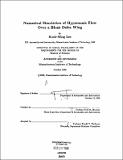Numerical Simulation of Hypersonic Flow Over a Blunt Leading Edge Delta Wing
Author(s)
Lee, Kuok Ming
DownloadACDL-TR-89-9.pdf (5.433Mb)
Terms of use
Metadata
Show full item recordAbstract
Euler and Navier-Stokes results are presented for a blunt delta wing at Mach
7.15 and 300 angle of attack. The viscous calculations were done at a Reynolds
number based on chord of 5.85 x 106 with freestream and wall temperatures set to
74K and 288K respectively.
The inviscid simulations were carried out using a finite volume, central difference
code written by Roberts [21] and Goodsell [7]. The Navier-Stokes results were
obtained on the semi-implicit extension of the inviscid code, developed by Loyd
[17].
The inviscid results showed a strong shock on the windward side of the wing
at a stand-off angle of about -5' from the body. As the flow traverses around the
leading edge it accelerates strongly through an expansion fan. On the upper surface
of the wing, separation occurs at about 60% span resulting in a region of reverse
cross stream flow.
The viscous calculations display a similar shock structure. Furthermore the
boundary layer on the windward side is thin and variations in the circumferential
direction are small. The flow on the leeward side of the wing separates in 2 places.
The primary separation occurs just inside of the leading edge, and the secondary
separation region is located further inboard.
The inviscid CL and CD are 0.547 and 0.383 respectively, whereas the viscous
values are 0.547 and 0.386. The viscous component contributes only an insignificant
2.32 x 10- S to the CD of the Navier-Stokes calculations.
Date issued
1989-10Publisher
Aerospace Computational Design Lab, Dept. of Aeronautics & Astronautics, Massachusetts Institute of Technology
Series/Report no.
ACDL Technical Reports;CFDL-TR-89-9
The following license files are associated with this item: